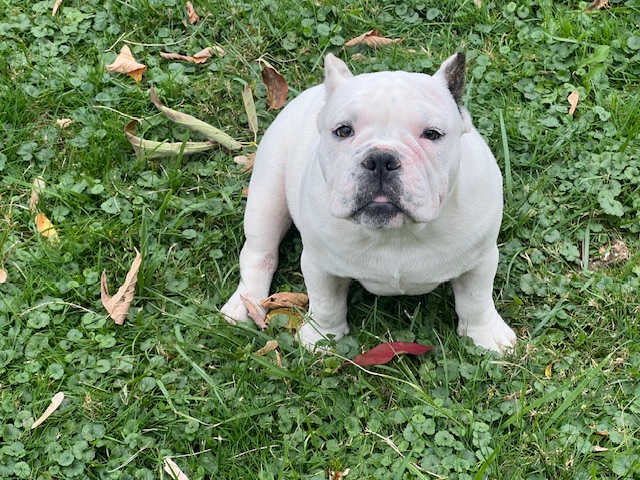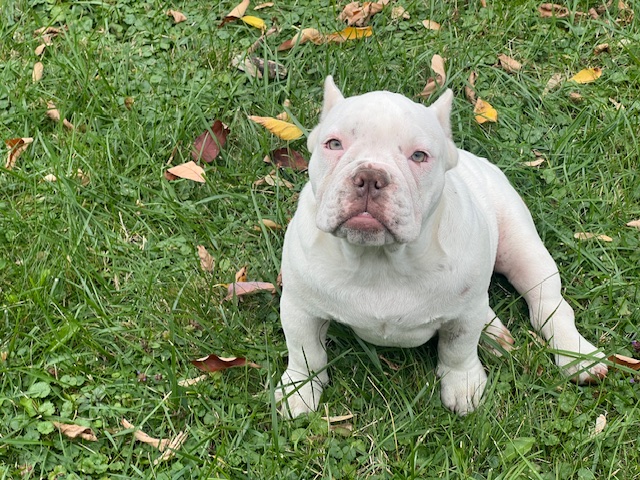Training your American Bully with positive reinforcement unlocks their full potential by focusing on rewards, clear communication, and consistency. When you replace outdated, punishment-based methods with kindness and effective incentives, your Bully learns faster, feels more confident, and builds a deeper bond with you. This comprehensive guide—covering why positive reinforcement works, how to start, basic and advanced commands, common challenges, and recommended tools—will equip you to master American Bully training at home.
Why Positive Reinforcement is Key for American Bully Training
What Is Positive Reinforcement?
Positive reinforcement in American Bully training means immediately rewarding desired behaviors so your Bully understands exactly what you expect. Instead of reprimands or harsh corrections, you add something positive—treats, praise, or play—to strengthen good habits. Every time your Bully offers behavior you like, you “mark” that behavior (with a clicker or verbal cue like “Yes!”) and reward. This approach leverages operant conditioning to create a strong “behavior → reward” connection.
Benefits Over Punishment-Based Methods
- Faster Learning Curve
Bully breeds respond especially well to food-based or play-based rewards. When they know staying seated or walking calmly on leash leads to a tasty bite or favorite toy, they repeat that behavior more readily than if they learn through fear of punishment. - Stronger Handler–Dog Bond
Positive reinforcement builds trust. Your Bully learns that you are the source of good things—food, fun, praise—so they seek to cooperate rather than cower or challenge you. This trust extends beyond training sessions into daily life. - Long-Term Retention
Dogs trained with rewards tend to hold onto commands longer and generalize them across different environments. A Bully who mastered “sit” in the living room will more likely stay seated at the vet’s office or during a backyard barbecue. - Reduced Stress and Anxiety
Harsh approaches (force, yelling, choke collars) can heighten anxiety, aggression, or stubbornness in Bullies. Positive reinforcement keeps your Bully relaxed, focused, and eager to please—making each session a win–win.
Getting Started with American Bully Training
Establishing a Clear Reward System
Before any training, decide what motivates your Bully most. For many Bully owners, high-value treats like small pieces of cooked chicken, cheese, or freeze-dried liver work wonders. If your dog is toy-driven, pick a favorite squeaky toy or tug rope. Consistency is crucial: always reward immediately when your Bully offers the correct behavior so they link the action to the payoff.
- Treat Placement: Keep treats in a treat pouch or pocket for easy access. Break larger treats into pea-sized bits so your Bully doesn’t fill up quickly.
- Switch It Up: Rotate between treats, toys, and praise to keep rewards novel and exciting.
- Marking the Behavior: Use a clicker (see below) or a consistent cue word (“Yes!”) to mark the exact moment the behavior occurs.
Selecting the Right Treats and Toys
- Small, Soft Treats: Easy to chew and swallow so your Bully stays focused (e.g., small cheese cubes, freeze-dried liver).
- Interactive Toys: A durable tug toy or ball can serve as a reward for Bully dogs that lose interest in treats quickly.
- Healthy Options: Opt for lean protein sources to prevent weight gain. Avoid overly fatty or sugary snacks.
- Treat Rotation: Every few weeks, rotate your treat options (e.g., chicken → salmon → turkey) to sustain high motivation.
Creating a Dedicated Training Space
Choose a quiet, low-distraction area—like your living room or fenced backyard—to start. Clear away chew toys or obstacles. A consistent location helps your Bully focus on training rather than new surroundings. Once they master commands there, you can gradually introduce mild distractions (family members passing by, other pets in the room).
Teaching Basic Commands to Your American Bully
Establishing solid fundamentals—sit, stay, come, down, and leave it—lays the groundwork for all future American Bully training. Each command builds impulse control, focus, and reliability.
Sit & Stay
- Lure to Sit: Hold a treat close to your Bully’s nose, then slowly move it upward and back over their head. As their head follows the treat, their bottom naturally lowers into a sit.
- Mark & Reward: As soon as their rear hits the ground, click (or say “Yes!”) and give the treat. Repeat five to ten times in short, 3–5 second sessions.
- Introduce “Stay”: Once “sit” is consistent, place an open palm facing your Bully’s chest and say “Stay.” Step one foot back. If your Bully remains seated, mark and reward. Gradually increase distance and duration in small increments: one step → two steps → three steps; one second → two seconds → five seconds.
Tips for Sit & Stay
- Keep sessions short (5 minutes max) to avoid fatigue and frustration.
- Always return to reward, never release by letting your Bully break position on their own. Use a release word like “Okay!” to signal freedom.
- If they break before release, calmly guide them back into position—no scolding.
Come (Recall)
- Leash & Treat Prep: Clip a long leash on your Bully in a distraction-free room. Crouch down, call their name excitedly followed by “Come!” in an upbeat tone.
- Mark & Reward: As soon as they turn and step toward you, click and lavish them with treats—five small bites per successful recall to reinforce reliability.
- Increase Difficulty: After consistent indoor success, move to the backyard or a quiet park on a 20–30 foot line. Repeat the call-and-reward sequence.
- Off-Leash Testing: Only in a fully fenced yard, test off-leash. Always have high-value treats or a favorite toy ready to reinforce when they come.
Tips for Reliable Recall
- Never call just to scold. Make “Come” the happiest word in their vocabulary.
- Mix up distances and environmental contexts—different rooms, outside spaces—to generalize the command.
- Use a secondary recall cue (e.g., whistle) to reinforce in noisy areas.
Down & Leave It
- “Down”: From a “sit,” hold a treat close to the floor between your Bully’s front paws. As their nose follows, body lowers into “down.” The moment they are lying flat, click and treat.
- Practice Sessions: Repeat in 3–5 second intervals. Add verbal cue “Down” as they reliably follow the lure.
- “Leave It”: Place a treat in a closed hand & show your Bully. They will sniff or paw. As soon as they stop trying and pull back, click and reward from your other hand.
- Advance “Leave It”: Place treat on floor, cover with your foot if they try to grab. Only when they step away, click and treat. Gradually add verbal cue “Leave it” before placing the treat.
Tips for Down & Leave It
- Impulse control builds foundation for polite behaviors—no jumping on guests, no counter-surfing.
- Always reward immediately when they choose the correct response.
- Practice intermittently throughout the day: mealtimes, before doors open, when guests arrive.
Advanced Training Techniques for American Bully Training
Once your Bully masters basic commands, you can introduce advanced methods—like clicker training, impulse control exercises, and structured socialization—to deepen obedience and confidence.
Clicker Training for Precision
A clicker is a small device producing a consistent “click” sound that marks the precise moment your Bully performs the target behavior. It bridges the gap between behavior and reward.
- Charge the Clicker: Over several short sessions, click and immediately treat 15–20 times to teach your Bully “click = treat.”
- Shape Complex Behaviors: For actions like “spin” or “target,” wait for a fraction of the behavior, click the instant they begin the motion, and treat. Over successive repetitions, your Bully picks up that the full behavior (e.g., full spin) earns rewards.
- Fade Out: As behaviors consolidate, transition from food to praise or toy rewards, but keep clicking to signal correctness.
Benefits of Clicker Training
- Precision: Marks exact moment of correct behavior, speeding up learning.
- Clarity: Removes guesswork—your Bully knows precisely what earned the reward.
- Flexibility: Works equally well for shaping tricks or fine-tuning everyday commands.
Building Impulse Control
American Bullies can be exuberant by nature. Impulse control exercises teach patience and focus:
- Door Manners: Before opening any door, insist on “sit–stay.” If your Bully lunges toward the threshold, close the door and restart the command. Only open once they hold “stay.”
- “Wait” at the Gate: Before exiting to the yard, ask for “wait.” Start with five-second holds, gradually extending to 20–30 seconds. Reward calm patience.
- Food Impulse Exercises: During meal prep, place a treat on the floor. If your Bully jumps or snatches, cover it and wait. The instant they back off, mark and reward with a different treat. Slowly introduce verbal “leave it” cues.
- Toy Impulse Control: When your Bully grabs a toy, flash a second toy or T-R-E-A-T to encourage trade for the better reward—honing listening and patience.
Over time, regular impulse drills translate to a calmer dog in everyday scenarios: no dragging you down the sidewalk, no lunging at squirrels, no frantic jumping when visitors ring the bell.
Socialization and Exposure
Proper socialization paired with American Bully training ensures a confident, well-adjusted dog:
- Enroll in Puppy or Adult Socialization Classes: Group sessions (puppy kindergarten or adult dog classes) let your Bully meet various ages, sizes, and temperaments of dogs under controlled supervision.
- Controlled Playdates: Coordinate one-on-one or small-group play with known, vaccinated dogs. Keep first encounters short (10–15 minutes) and terminate on a positive note.
- Environment Desensitization: Introduce household noises—vacuum, blender, doorbell—at low volume, rewarding calm reactions. Gradually raise the volume as they acclimate.
- Public Outings: Take your Bully to dog-friendly stores, parks, or outdoor cafés on a leash. Reward polite greetings, calm behavior around strangers, and focus despite mild distractions.
Socialization builds confidence and reduces fear-based reactions. A well-socialized Bully is less likely to develop aggression or anxiety when encountering new people, dogs, or environments.
Common Behavior Challenges and Solutions in American Bully Training
Even with stellar basics, American Bullies may present behavior hurdles. Address them head-on using positive reinforcement tactics.
Leash Pulling
Problem: Your Bully lurches ahead, dead-lining you on daily walks.
Solution:
- Stop-and-Go Method: The instant the leash tightens, stop walking. Wait until your Bully relaxes the leash—head swivels, tail lowers—then mark (“Yes!”) and reward with a treat. Resume walking. Repeat each time they pull.
- Change Direction: When pulling begins, pivot sharply and walk the opposite way, luring your Bully to follow. The moment they follow without tension, click and treat. This teaches your Bully to watch you rather than forging ahead.
- High-Value Treats on Hand: During initial training, carry their favorite treats (bits of cooked chicken or cheese). Offer a treat every few steps to reinforce walking beside you.
Consistency is crucial. Every single tug must trigger the stop or turn for leash etiquette to solidify.
Jumping and Mouthing
Problem: Your Bully leaps up or mouths hands when greeting people or during play.
Solution:
- Ignore & Reward Alternative: When your Bully jumps, turn away and keep your arms at your sides—no eye contact. Wait until all four paws are on the ground, then mark (“Yes!”) and reward with a treat. This teaches that calm behavior earns attention.
- Teach “Sit” as an Alternative: Every time guests arrive, cue “Sit” before greeting. Reward them for remaining seated while people pet them. Over time, the Bully associates staying seated with positive outcomes.
- Redirect Mouthing to Toys: Carry a designated chew toy during play. If your Bully mouths your hand, calmly offer the toy; once they accept it and chew appropriately, praise and lightly tug.
Replacing unwanted behaviors with rewarded alternatives prevents reinforcement of jumping or mouthing through awkward attention.
Separation Anxiety
Problem: Your Bully becomes frantic, destructive, or howls when left alone.
Solution:
- Desensitize Departure Cues: For days, practice “departure drills.” Pick up keys, put on your shoes, pause, remove shoes, set keys down—repeat multiple times without leaving. This breaks the association between those cues and actual departures.
- Gradual Alone Time: Begin with just 30 seconds in another room, returning before any sign of distress. Reward calm behavior once you re-enter. Gradually extend to one minute, then two, then five.
- Interactive Toys & Food Puzzles: Provide long-lasting distractions—Kong toys stuffed with peanut butter or interactive puzzle feeders—when you leave. This builds a positive association with your absence.
- Crate Training as a Safe Space: Teach your Bully to view the crate as a cozy den. Start with short crate sessions—5 minutes—adding treats inside. Increase duration only when they remain calm. Never use the crate as punishment.
With consistent desensitization and positive associations, separation anxiety gradually diminishes, replaced by calm independence.
Training Tools and Resources for American Bully Training
Having the right gear and reference materials accelerates progress. Below are recommended clickers, harnesses, collars, mats, and crates tailored to the Bully build and temperament.
Clickers for Precision Timing
- Karen Pryor i-Click Clicker (Outbound): This clicker’s crisp, consistent “click” helps mark exact moments of correct behavior. Its ergonomic shape fits comfortably in your hand, letting you train both basic commands and complex tricks efficiently. Learn more about clicker training on Wikipedia.
- PetSafe Clik-R Clicker: Reliable, affordable, and loud enough for outdoor training. Its simplicity suits beginners and experienced trainers alike. Using a clicker clarifies the desired behavior for your Bully, speeding up learning and reducing frustration.
Harnesses and Collars for Safe Walking
- Front-Clip Harness (e.g., Easy Walk Harness): Discourages pulling by gently redirecting your Bully’s shoulders toward you when they lean forward. This is ideal for Bullies prone to lunging or dragging on walks.
- Martingale Collar: Provides control for dogs that slip out of traditional collars, without choking. When fitted properly (snug but not tight), it offers security without discomfort.
- Head Halter (e.g., Gentle Leader): Offers steering control for strong pullers. Use with caution—introduce gradually to prevent neck strain. Pair with positive reinforcement to ensure your Bully associates head halter with treats and praise rather than discomfort.
Mats and Crates for Structure
- Training Mat (“Place” Command): A designated mat creates an “on-duty” zone. Teach your Bully to go to the mat on cue (“Place”) and reward them for staying. Ideal during mealtime prep, greeting guests, or when you need them contained.
- Crate: A sturdy, appropriately sized crate (large enough to stand, turn, and lie down) becomes a safe haven if introduced positively. Use treats and chew toys inside. Keep crate doors open initially so your Bully chooses to explore it. Only close the door for brief sessions, gradually increasing time as they remain calm.
Maintaining Consistency and Tracking Progress
Consistency in American Bully training ensures that good habits stick. A structured approach—documenting sessions, adapting for life stages, and knowing when to seek help—keeps you and your Bully on the same page.
Keep a Training Journal
Create a simple log—handwritten or digital—with:
- Date & Duration: Note session length (ideally 5–10 minutes, 2–3 times daily).
- Commands Practiced: List “sit,” “down,” “recall,” etc.
- Rewards Used: Treat type, toy, praise.
- Success Rate: Percentage of correct responses (e.g., “Sit: 8/10”; “Recall: 5/5”).
- Distractions Introduced: Children playing, other dogs, cars outside.
- Notes & Adjustments: E.g., “Needs more treats to focus around bikes.”
Review weekly. If “sit” success at home is 90% but drops to 50% in the park, adjust for higher-value rewards or lower distractions until consistency improves.
Adjusting for Age and Temperament
- Puppies (8–16 weeks): Extremely short attention spans—4–5 minute sessions. Focus on socialization and potty training alongside basic commands.
- Adolescents (6–18 months): Teenage Bully phase—sometimes rebellious. Increase puzzle toys and interactive games to maintain mental stimulation. Keep training engaging and upbeat.
- Adults (2+ years): Often learn commands more quickly due to maturity. Monitor weight—switch to puzzle games over treats to prevent obesity. Continue socialization to prevent adult-onset reactivity.
Temperament varies among Bully lines: some are intensely food-motivated, others respond better to tug and play or social praise. Match your reward system to your Bully’s individual drive.
When to Seek Professional Help
If your Bully shows aggressive behaviors (growling, snapping, biting) or severe fear/anxiety, consult a certified professional. A qualified Certified Professional Dog Trainer (CPDT-KA) or veterinary behaviorist can assess underlying issues and create a personalized behavior modification plan. Do not delay intervention; early professional guidance prevents escalation.
Next Steps and Additional Resources for American Bully Training
Below are five vital inbound resources from CapCity Bullys and two authoritative outbound references to deepen your American Bully training knowledge:
CapCity Bullys Pennsylvania Resources
- E-Book: The American Bully
Download our comprehensive guide covering breed history, conformation, health, and advanced training exercises: E-Book: The American Bully. - Puppies for Sale
If you’re looking to bring home a puppy to train, view our available litters here: Puppies for Sale. - CapCity Bullys Blog
Stay informed with articles on Bully health, nutrition, breeding updates, and training tips: CapCity Bullys Blog. - Puppy Health Guarantee
Ensure your new Bully starts life with health screenings, vaccinations, and clear health protocols: Puppy Health Guarantee. - Puppy Purchase Contract
Review the specifics of ownership responsibilities, guarantees, and breeder support: Puppy Purchase Contract.
Outbound Resources
- American Kennel Club – Positive Reinforcement Training
Learn scientifically backed methods for reward-based training and behavior shaping: AKC Positive Reinforcement Guide. - Wikipedia – Clicker Training
Explore the principles of operant conditioning and how clicker devices expedite learning: Clicker Training Overview.
Find Your Perfect American Bully Puppy for Sale Today — Nationwide & Worldwide Delivery Available
Welcome to Cap City Bullys — The #1 Choice for Show-Quality American Bully Puppies
At Cap City Bullys, we’ve spent 15+ years perfecting the art of breeding purebred, registered American Bully puppies that stand out for their muscular conformation, rock-solid health, and calm, even temperaments. Located in Erie, Pennsylvania, our family-run kennel serves bully enthusiasts from New York to California—and ships champion-line puppies safely across the globe.





